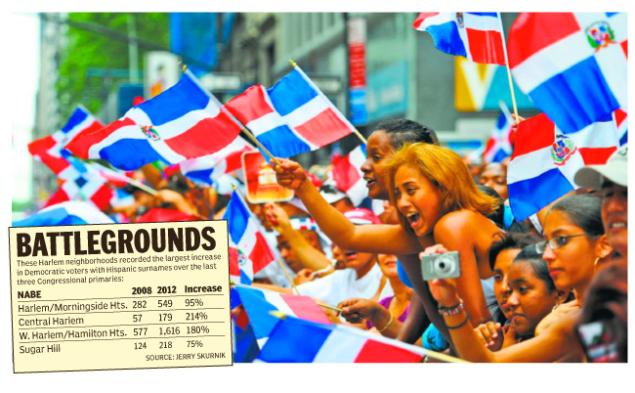It’s the uptown version of the purple state.
Dominicans are gnawing away at the once-stable black power base as new voting trends show Latinos throughout upper Manhattan — and especially in Harlem’s emerging battleground pockets — are flocking to the polls in increasing numbers.
A rising number of Hispanics are registering to vote in neighborhoods that were traditionally dominated by black residents.
The shifts are painting a new political landscape north of W. 125th St. — in precincts that helped David Dinkins, Basil Paterson, Percy Sutton and Charles Rangel build New York’s first black political stronghold.
The contested districts — which encompass Hamilton Heights, Sugar Hill and the Harlem-Washington Heights border — could be the decisive factor in Rangel’s bid to serve a 23rd term in Congress, experts said.
“You have to pay attention to the Dominicans. It would be a mistake not to,” said veteran Democratic consultant Hank Sheinkopf.
“Dominicans have, in the past, not voted in great numbers. But in recent years their turnout has increased. Dominicans are increasing in power. They are more rooted. African-Americans are declining in numbers.”
Blacks are leaving the city’s historically African-American neighborhoods in droves.
Harlem and Washington Heights lost 16% of their black population since 2000, the most recent city census numbers showed. But the rates were even more startling in Hamilton Heights and West Harlem, which recorded a 25% loss.
Sugar Hill and its surrounding pockets saw the Latino population climb by 58%.
“The Dominican vote has been a growing segment for Northern Manhattan,” said political consultant Jerry Skurnik, who crunched a decade’s worth of voting stats to illustrate the trend. “No candidate can afford to ignore them.”
This generation of Harlem Latinos is flexing its civic muscle more than in years past. Among Democrats who registered to vote there within last decade, nearly one-third are Hispanic.
And Latino voters are boosting their numbers at the polls. In Hamilton Heights, voters with Hispanic surnames nearly tripled their turnout over the last three congressional election cycles, according to data culled by Skurnik.
In the last three citywide races, their participation rose by 19%.
“They are one of the most energetic and responsive communities that I have run across in my life,” said Attorney General Eric Schneiderman, who represented Washington Heights in the state Senate for eight years.
The numbers seem clear enough, but they didn’t ruffle Rangel or his presumptive opponent, Dominican state Sen. Adriano Espaillat (D-Washington Heights), who came within less than 1,000 votes of toppling Rangel in 2012.
“Congressman Rangel will keep fighting for the interests of the Dominican community and every community in the 13th District,” said campaign spokesman James Freedland, noting that the district is also home to Puerto Ricans, Jews and West Africans.
Espaillat said his focus was on issues — not on the area’s ethnic composition.
“We’re all facing the same economic challenges, and need to fight for our needs with one voice,” Espaillat said.
The evolving dynamics mirror a broader trend uptown, where lifelong politicos are finding it impossible to ignore the newcomers and have begun to forge fresh alliances.
“The tension isn’t racial. If there is tension, it’s purely political,” said Assemblyman Keith Wright, the Manhattan Democratic Party boss, of the calcifying Dominican bloc in Harlem.
“It’s those folks who are helping one candidate over another,” he added. “That’s the natural order of political races.” [Daily News]



